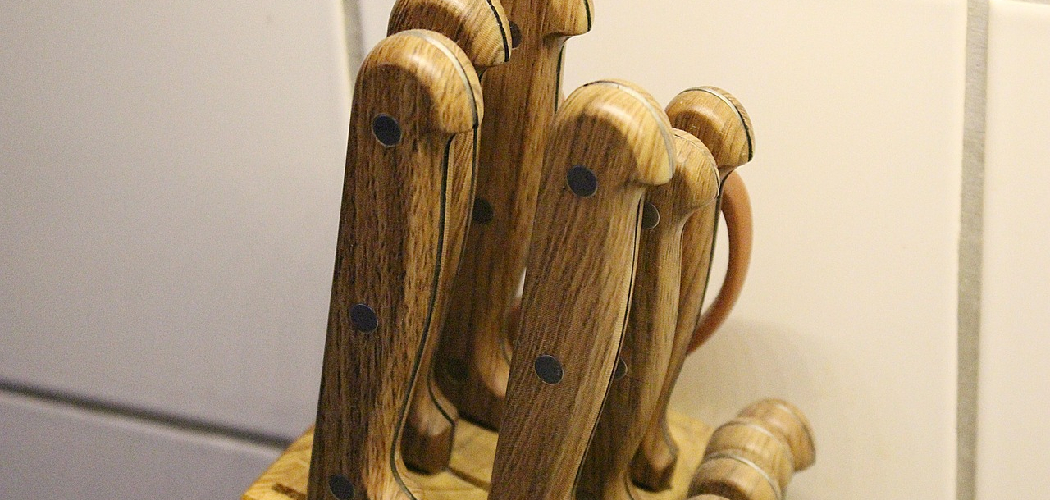Are you interested in creating a quality kitchen knife that will last through years of use? Learning how to waterproof a wooden handle for your knife is an essential step in ensuring its durability and long-term performance.
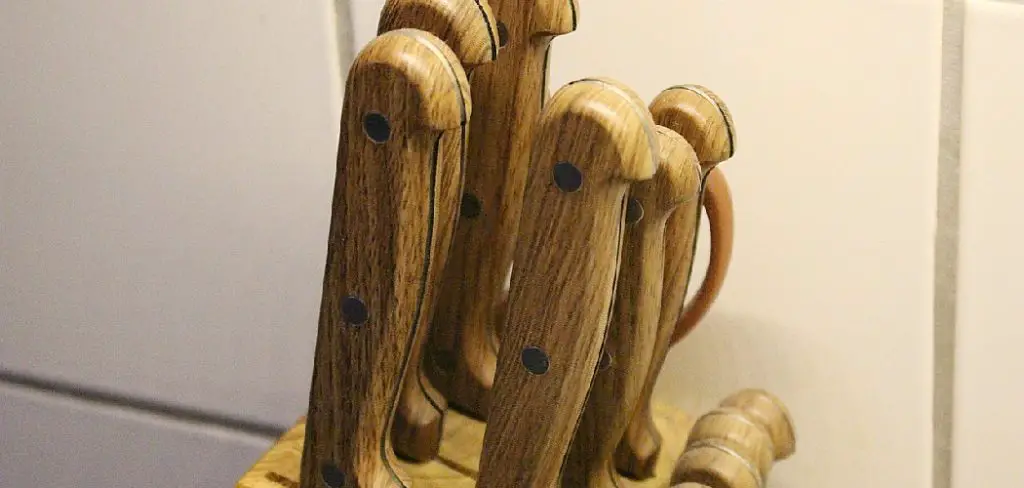
In this blog post, we’ll discuss the different methods for how to waterproof a wooden knife handle, from natural solutions like linseed oil and beeswax to synthetic alternatives like epoxy paints and marine varnishes. Plus, get helpful tips on cutting board maintenance after combating water damage to keep your knives looking sharp for many years!
10 Best Methods on How to Waterproof a Wooden Knife Handle
1. Use Linseed Oil:
One of the oldest and most common methods of waterproofing a wooden knife handle is with linseed oil. This natural substance provides a protective coating on the wood that repels moisture and prevents water damage. Simply rub the handle down with the oil using a clean cloth or brush, then leave it to cure overnight or longer. Using linseed oil regularly will not only help waterproof the handle but also enhance its beauty and give it a beautiful golden hue.
2. Use Beeswax:
Another common natural solution is to use beeswax on the wood. This natural wax provides a great barrier against moisture while also giving your knife handle an attractive shine and pleasant fragrance. To apply, melt some beeswax in a double boiler, then brush the melted wax onto the handle with a clean cloth. Allow it to set overnight before using your knife.
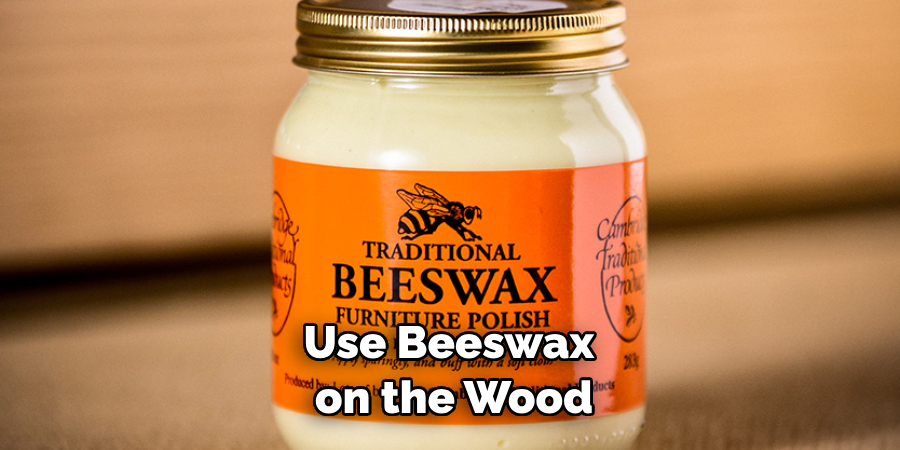
3. Use Epoxy Paints:
Epoxy paints are a synthetic solution for waterproofing wooden handles that can be applied quickly and easily with spray cans, brushes, or rollers. They provide an excellent barrier against moisture and can also be used for a variety of other projects where waterproofing is necessary. If you choose this method, make sure to take the proper safety precautions when handling epoxy paints.
4. Use Marine Varnishes:
If you’re looking for a more durable solution, marine varnishes are an excellent option. They provide an extremely tough waterproof coating that can last for years and are designed specifically to withstand the harsh conditions of marine environments. To apply, follow the instructions on your varnish and make sure to carefully sand down the handle beforehand.
5. Use Polyurethane:
Polyurethane is another synthetic option for waterproofing a wooden knife handle. It provides a lasting protective coating and is available in both oil-based and water-based forms. To apply, make sure to sand down the wood before beginning and then brush on multiple coats of polyurethane until you have achieved your desired level of protection.
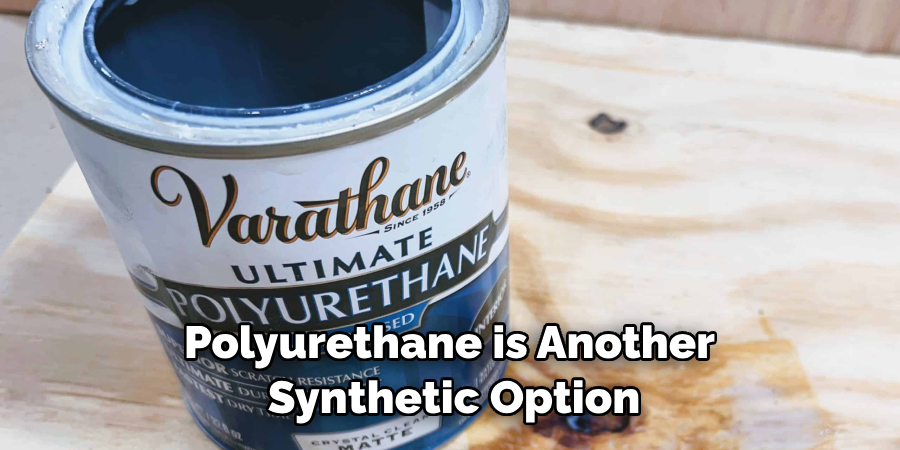
6. Use Teak Oil:
If you’re looking for an environmentally friendly solution, teak oil is the way to go. This natural oil penetrates deep into the wood to provide a long-lasting waterproof coating that also helps to nourish and protect it from damage. To apply, simply brush on multiple coats of teak oil and allow them to dry in between applications.
7. Use Mineral Oil:
Mineral oil is an affordable and easy-to-find option for waterproofing a wooden knife handle. It penetrates the wood deeply to provide protection from moisture and water damage while also helping to nourish it. To apply, simply brush on multiple coats of mineral oil and allow them to dry in between applications. This method is great for those who want a quick and easy solution.
8. Use Beeswax and Mineral Oil:
Combining beeswax and mineral oil is an effective way to waterproof a wooden handle without having to use any synthetic solutions. To apply, mix equal parts of beeswax and mineral oil together until you have a paste-like consistency. Then, brush it onto your handle with a clean cloth and allow it to cure overnight before using your knife. This will also help nourish the wood and give it a beautiful golden hue.
9. Use Epoxy Resins:
Epoxy resins are a durable and long-lasting solution for waterproofing wooden handles. To apply, mix the two parts of the epoxy resin together until they form a smooth paste. Then, brush it onto your handle with a clean cloth and allow it to fully dry before using your knife. Using epoxy resins will give you a waterproof coating that will last for many years.
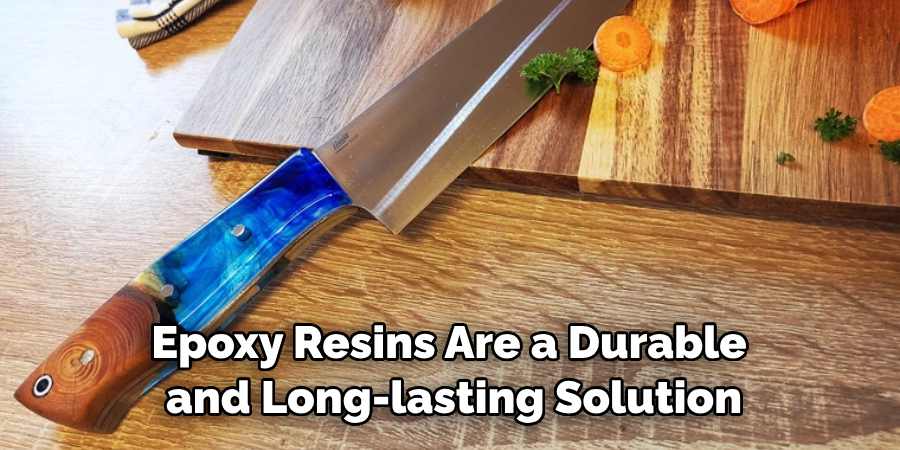
10. Use Wood Glue:
Wood glue is another effective way to waterproof a wooden handle. To apply, simply spread a thin layer of wood glue onto the handle with a brush or cloth and allow it to dry overnight before using your knife. Just make sure not to get any of the glue on the blade as this can dull its sharpness over time.
Once you have applied your chosen method of waterproofing, make sure to properly maintain your wooden knife handle by regularly wiping it down with a damp cloth and applying extra coats of protection as needed. Taking these steps will ensure that your knife handle stays in great condition for many years to come.
Additional Tips and Tricks to Waterproof Wooden Knife Handles
1. If you don’t want to replace the entire handle, you can seal and coat the existing one with thin layers of waterproof finish. First, rub a light layer of mineral oil onto the wood, let it soak in for about 15 minutes, then wipe off any excess. After that, apply at least two coats of waterproof finish using a brush or cloth, allowing each coat to dry before applying another.
2. Consider a waterproofing resin for your knife handle. This material is designed to protect wood from moisture and rot while still maintaining its natural beauty. It’s easy to apply with a brush or cloth, and it dries quickly even in high-humidity conditions.
3. If your knife handle is made from a softer type of wood like pine or cedar, consider protecting it with an epoxy sealer. This will waterproof the wood and make it more durable. To apply, first, sand down the handle with medium-grit sandpaper to remove any imperfections. Then use a brush or cloth to apply two coats of epoxy sealant, allowing each coat to dry before applying the next.
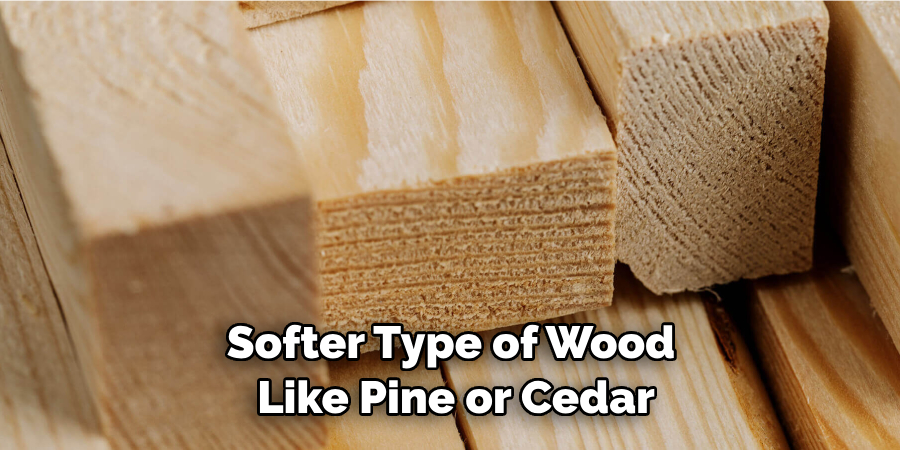
4. If you want an extra layer of protection, try a marine-grade varnish on your wooden knife handle. It’s specially formulated to resist water, salt, and UV rays. Apply at least three coats with a brush or cloth for maximum waterproofing protection. Allow it to dry completely between each coat for best results.
5. For a natural finish that will also protect your handle from moisture, consider using beeswax or carnauba wax. These products are easy to apply and help to seal the wood against water damage. To apply, melt a small amount of wax in a double-boiler or microwave, then rub it onto the handle with a cloth or brush until it’s evenly distributed. Let it cool for a few minutes, then buff off any excess with another cloth.
By following these tips and tricks you can easily waterproof your wooden knife handle and protect it from moisture and rot for years to come. Just remember to take the time to choose the best product for your needs and apply multiple coats for maximum protection. With proper care and maintenance, your wooden knife handle can stay looking great for a long time.
Things You Should Consider to Waterproof a Wooden Knife Handle
1. Choose a method of waterproofing that is best suited for the type of wood used in the handle. Different types of wood will require different types of sealants to effectively protect them from water damage. Some sealants may work better on more porous woods, while others will provide better protection for denser woods.
2. Consider how much temperature fluctuation the wooden handle will be exposed to. Wood expands and contracts according to temperature changes, so a sealant that can withstand extreme temperatures is important for maintaining a waterproof surface.
3. Consider the wear-and-tear the knife handle will be subjected to. A stronger sealant might be required if you expect your knife handle to face frequent use or heavy wear.
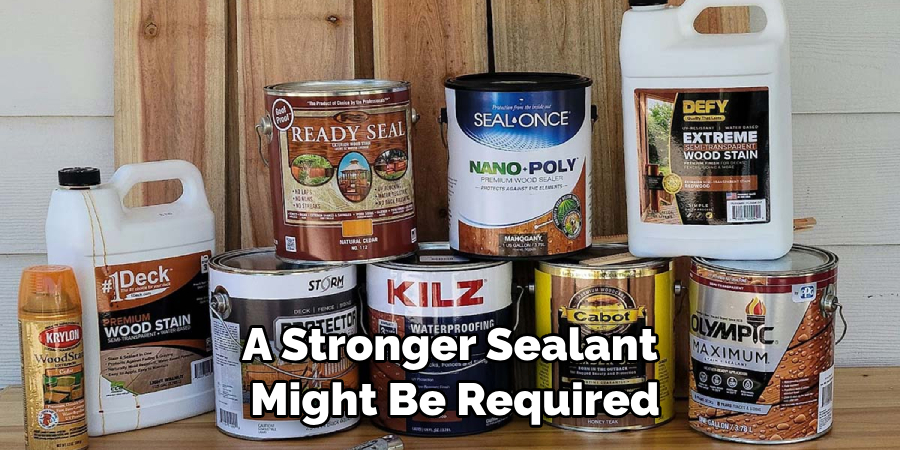
4. Choose a sealant that is easy to apply and maintain. Waterproofing your wooden handle should be an uncomplicated process, so make sure you choose one that won’t require several coats of product or multiple levels of application.
5. Select a sealant that will provide long-term protection for your knife handle. You should look for a sealant that will last and keep your knife handle safe from water damage for many years.
By considering these factors, you can ensure that your wooden knife handle is effectively waterproofed and protected from damage. This will help keep it looking great and functioning properly for the long term.
Frequently Asked Questions
What Are the Benefits of Waterproofing a Wooden Knife Handle?
Waterproofing a wooden knife handle can extend its life by protecting it from moisture damage, such as warping and cracking. It also prevents the buildup of bacteria and other contaminants that can cause health issues.
What Is the Best Way to Waterproof a Wooden Knife Handle?
The best way to waterproof a wooden knife handle is by sealing it with a waterproofing sealant or varnish. This will protect the wood from moisture and other contaminants, as well as give it an attractive finish. Be sure to follow the directions on the product carefully to ensure maximum protection.
Are There Any Alternatives to Waterproofing?
An alternative is to use a non-porous material such as fiberglass or plastic for the handle of your knife. These materials are not susceptible to water damage and can be wiped clean with ease. However, many people prefer the look and feel of a wooden knife handle.
Can I Make My Own Waterproofing Solution?
Yes, you can make your own waterproofing solution using a mixture of beeswax and mineral oil. This mixture will protect the handle from moisture damage while also preserving its natural beauty. Be sure to follow the safety instructions when making this solution, as it can be quite hazardous if not handled properly.
Is There Anything Else I Should Know About Waterproofing a Wooden Knife Handle?
Be sure to choose the appropriate sealant or varnish for your wooden knife handle. The wrong product can lead to damage and discoloration of the wood, so it is best to consult with an expert before making a purchase.
Additionally, be sure to test any waterproofing solution on a small area of the handle before applying it to the entire surface. This will help you ensure that the solution is compatible with your wooden knife handle.
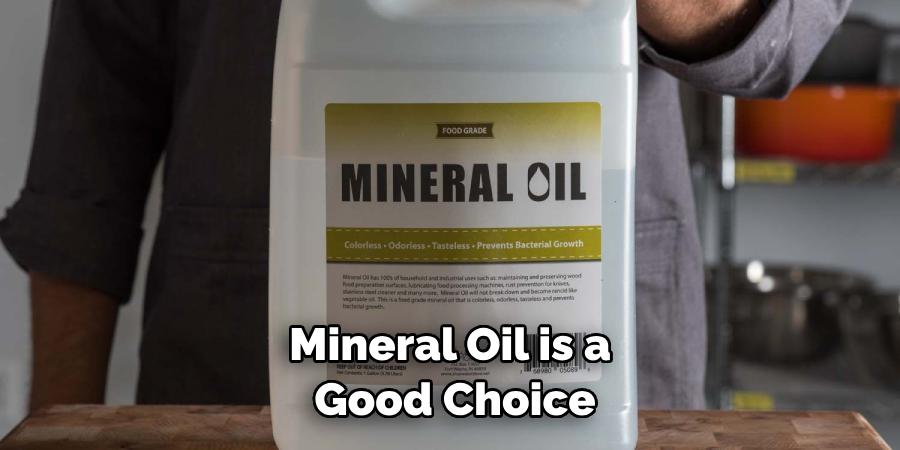
Which Oil Will Be Better for Waterproofing a Wooden Knife Handle?
Mineral oil is a good choice for waterproofing wooden knife handles, as it creates an effective barrier against moisture. The oil should be applied in thin layers and allowed to soak into the wood before being wiped away. Additionally, beeswax can be used on top of the mineral oil for additional protection and a glossy finish.
Conclusion
Feel more confident in carving deep into liquids, condiments, woods, and whatever else your knife needs to touch with our tips. If you did it yourself now, be sure to check for leaks monthly as part of your maintenance routine and re-waterproof as needed. If you take care of the wooden knife handle properly, it will last forever!
To ensure longevity for your wooden handles, we recommend that they are waterproofed with a sealant like epoxy or varnish as soon as possible. Adding a layer of oil or wax every month is also a great way to keep the wood moisturized and protected.
Now that you have learned how to waterproof a wooden knife handle, don’t forget to put these tips into action! There is nothing quite like the feeling of having an expertly crafted blade made specifically for you. Knowing how to waterproof a kitchen or pocket knife will give you added peace of mind when caring for this timeless tool. So go ahead and waterproof your wooden knife handle today!
you can check it out also Sharpen a Knife with Bench Grinder

